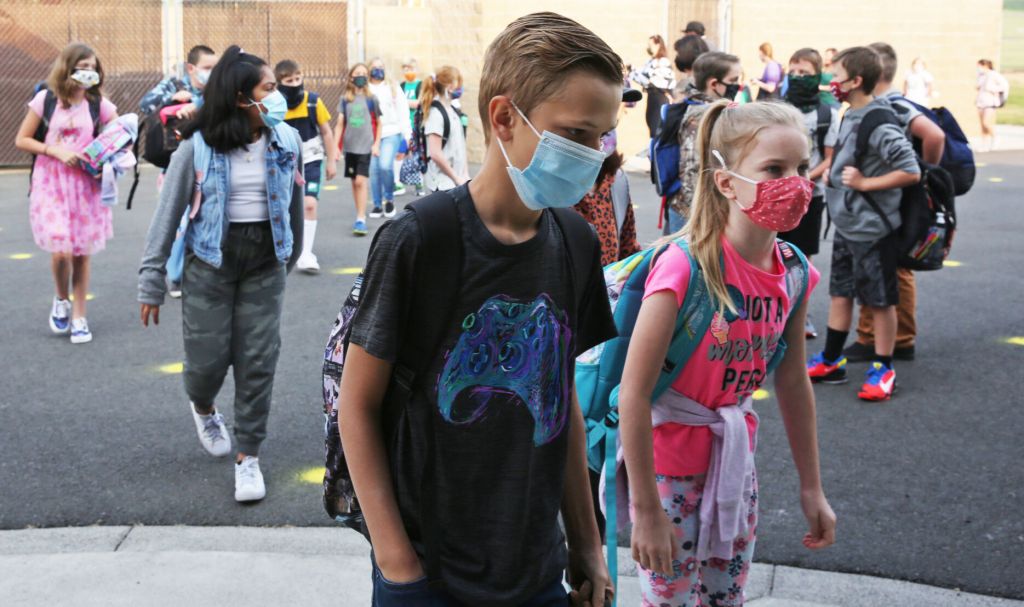Oregon will lift mask mandate on May 12 as pandemic hits two-year mark
Published 9:49 am Monday, February 28, 2022

- Students wear masks as they file into Sage Elementary School on the first day back to school in Redmond.
Plummeting COVID-19 hospitalizations have moved up the day that indoor masks will no longer be mandatory to March 12, Gov. Kate Brown said Monday.
Oregon, California and Washington issued simultaneous announcements on Monday morning saying they would unmask at the same time, a major change in the pandemic for 51 million people in states along the Pacific Ocean between Canada and Mexico.
Trending
The announcement came on the two-year anniversary of the first reported case of COVID-19 in Oregon.
“As has been made clear time and again over the last two years, COVID-19 does not stop at state borders or county lines,” Brown said in a statement. “On the West Coast, our communities and economies are linked. Together, as we continue to recover from the omicron surge, we will build resiliency and prepare for the next variant and the next pandemic.”
The earlier date comes as Brown also prepares to end the pandemic state of emergency on April 1. It has been in place since March 2020. The emergency gave Brown and the Oregon Health Authority significant control over public health decisions from business closings, event sizes, mask wearing, social distancing and vaccination distributions. It also set off a backlash in counties were views on the virus and vaccines ranged from hesitant to belligerent.
The March 12 end of the mask mandate would turn over control of pandemic safeguards to local communities and school districts. Oregon Department of Education Director Colt Gill said the new policy would include schools, though each district could decide what level of safeguards it wanted to keep and individual students would be allowed to continue wearing masks if they wished.
In the three states, the change in policy would affect more than 7.5 million school-age children.
OHA said the lifting of the mask mandate did not include changes to federal and state rules on masks in health care settings, airline flights, public transit, and other specialized settings. Updates will be provided in coming days and weeks.
Trending
Dr. Dean Sidelinger, the state epidemiologist, said OHA was unlikely to move the March 12 date up any earlier. Brown at the beginning of the month said mask mandates could be dropped once the daily number of people in hospitals with COVID-19 fell below 400.
As the momentum of the steep drop in hospitalizations caused by the omicron variant accelerated, the date has moved from March 31 to March 19 and now March 12. Even if the number goes below 400 this week, Sidelinger said the state plans on keeping the March 12 date so that the move can be made simultaneously with California and Washington.
OHA said the data it had received and comparisons on how the omicron surge rose and fell in other states and in European counties was solid enough that they did not believe lifting the masking rule would result in the state being blindsided as it was last summer during the delta surge.
More people are vaccinated and the limited natural immunity of those who contracted delta or omicron leaves a much smaller target for the virus to hit.
“We move into this next phase with significantly less disease, significantly higher immunity in our communities, and face the virus in front of us, not the virus behind us that we faced in July of last year,” Sidelinger said.
The move by Oregon comes as the Centers for Disease Control and Prevention late last week called for new guidelines to determine risk. Using a formula that differs from caseloads and positive infection rates, it measured the likelihood of hospitals being overtaxed if restrictions were relaxed. It reported 70% of the U.S. population lived in areas where masks mandates and other safeguards could be loosened.
Unfortunately for Oregon, the CDC map shows much of the eastern, central and southwestern parts of the state as in the 30% high risk category. The Portland area, and counties along the Columbia and Snake rivers were moderate risk, while Malheur and Grant counties were low risk.
OHA said that the CDC map should be a guide for local officials as they determine the level of safeguards they want to put in place beyond the relaxed mandate.
Brown said the changes after March 12 will be a window into the relative normalization of living with COVID-19 as a public health issue, but not an ongoing emergency.
“We will build resiliency and prepare for the next variant and the next pandemic,” she said. “As we learn to live with this virus, we must remain vigilant to protect each other and prevent disruption to our schools, businesses, and communities – with a focus on protecting our most vulnerable and the people and communities that have been disproportionately impacted by COVID-19.”




